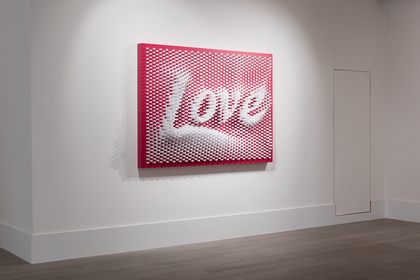-
From Current Issue
-
- Editor’s Letter Fire in the Heart
- Reviews I Gusti Ayu Kadek Murniasih
- Reviews 11th Seoul Mediacity Biennale: “One Escape at a Time”
- Dispatch Networked China
- One on One Monira Al Qadiri on Yukio Mishima
- Essays The rise of independent art spaces in pandemic-era Shanghai
- Features Tuan Andrew Nguyen
- Table of Contents
- Web Exclusives
- Archive
- Subscribe

R
E
V N
E
X
T
Installation view of RAMIN SHIRDEL’s “I Am Transforming into You” at Sophia Contemporary Gallery, London, 2017. Courtesy the artist and Sophia Contemporary Gallery.
Slightly altering the title of Ramin Shirdel’s new exhibition at London’s Sophia Contemporary, “I Am Transforming into You,” is revealing. Change it to “I is transforming into you,” and suddenly these two pronouns are stripped of all the life and meaning that pervades them. All that remains are two hollow signs, just letters and sounds. Such is the instability of language, that tiny transformations or changes of perspective can alter the nature of the words we use, or denature them entirely. From these ambiguities we derive poetry, comedy, philosophy, jurisprudence and, in Shirdel’s recent works, art.
The artist’s sculptural depictions of English and Farsi words, made of wood and coated with faintly glossy car paint, are understandably equated with pop art, and there are also similarities to Italian spatialism. The influence of this latter movement, which ambitiously sought to translate the virtual space of traditional painting into physical space though a union of art and science, is given weight by Shirdel’s training as an architect, an occupation whose modus operandi is translating the theoretical into the physical. However, with these works, the artist is not simply adjoining a third dimension to two, but rather giving physical expression to the invisible space between signs and semantics, practicing a kind of linguistic spatialism.
In Soul/Mind (2017), Shirdel uses a layering technique developed in his architectural practice to create a sculptural depiction of the two eponymous nouns. On one side of the piece, the word “Soul” is constructed from a plane of white-painted wood, with further layers receding concertina-like behind it, twisting with each iteration before concluding in a new form: “Mind.” Here is another quirk made possible by the ambiguities of language: we often use spatial metaphors to describe abstract ideas. “Soul,” we can say, is relatively close in meaning to “Mind,” just as “Wise” and “Wild”—interpreted as an antonymous pair—are semantically far, although near in pronunciation and spelling. The technique employed in Soul/Body is repeated in yellow-painted wood in Wise/Wild (2017), but its linear recession of layers does little to explore or express this extra axis of sound.
The phonetic aspect of language is suggested elsewhere. In Eyn Shin Ghaf (White) (2016), the three eponymous Farsi letters, which spell a word whose meaning is close to “love” are presented in three separate white reliefs, where vertical planes of wood protrude perpendicularly to square bases. The resulting characters, which are illusorily smooth when viewed from afar, resemble sonar maps, and the linguistic terrain they represent is, again, ambiguous: as with all alphabetic scripts, but especially as presented here, the letter-names spelled out in the title share no intrinsic relation to the three distinct characters on the wall, or the sounds and meaning they suggest.
From one reading of the word to another, a further sculpture, similar in form to Soul/Mind and Wise/Wild, focuses on a different kind of “characters.” Leily/Majnoon (2017), has for its two extremities the name of a woman and the nickname (meaning “crazy”) of a man. They are the principle characters of a famous 7th-century Arabic love story, later rendered into Persian by Nizami Ganjavi in the 12th century. While this piece could be read in various appealing ways—for instance, with heroine and hero as separate sides of the same entity—this foray into sentimentality detracts from the meanings attached to Shirdel’s sculptural approach elsewhere.
A sentimental moment that plays more to the exhibition’s strengths was to be found in White Love and Feel (both 2016), where many individual bars jut forward from rectangular bases to put whole words in relief. The white rods that spell Love on a pink background, like the red ones that spell Feel against gray, interact as the viewer moves around them. Consequently, the visual definition of these nouns, like their semantic definition, is subject to change according to perspective.
The deeper we dig into the meanings of words, the harder it is to pin them down. It is, then, perhaps understandable that the creations in “I Am Transforming into You” sometimes lose sight of any single focus. Regardless, they engage with questions that will be relevant as long as there are words to discuss them.
Ramin Shirdel’s “I Am Transforming into You” is on view at Sophia Contemporary Gallery, London, until September 22, 2017.
To read more of ArtAsiaPacific’s articles, visit our Digital Library.








